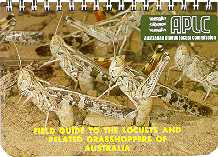In line with its Charter the APLC undertakes a wide range of communication and engagement activities to provide information, advice and support to stakeholder agencies, landholders and the general community.
The APLC has ongoing engagement with state and local agencies involved in pest locust management to ensure the coordination of activities and to provide information on the current locust situation and regional forecasts. It also promotes and facilitates adoption of best practice for pest locust management in member states through the release of research project results and the provision of specialist technical advice.
The APLC operates a locust monitoring and forecasting system for operations conducted by APLC and member states, publishing the compiled results in its monthly Locust Bulletins to give an update on the current locust situation and regional forecasts. The Bulletin and Current Situation updates are posted on the APLC website, which is a major vehicle for the delivery of timely and relevant information to stakeholders and the general community.
Pre-season planning forms an important element of APLC’s engagement with state and local agencies, landholders and regional communities. These planning activities make extensive use of the forecasting and related information generated by APLC. Part of the seasonal plan resulting from this engagement is a communications plan which identifies the information needs of various target audiences and appropriate delivery mechanisms.
A number of promotion and awareness tools are available to facilitate information exchange, including brochures, a locust identification guide, information sheets and training videos.

A field guide to the locusts and grasshoppers of Australia was published by the APLC in 1998 to assist the identification of economically important species. An HTML version of the Locust and Grasshopper Identification Guide is available on this website.
Training and Consultancy
The APLC delivers training to staff from state and local agencies in the identification, survey and control of locusts. This training incorporates relevant elements of the APLC’s best practice operations, including those based on the outcomes of APLC’s research and development program.
The APLC also undertakes international consultancies on locust and grasshopper management. We offer objective and impartial advice on how to control locusts and how to develop effective forecasting procedures. APLC staff have completed consultancies in Timor Leste, Indonesia, Yemen, Tanzania and Laos, and regularly engage with international counterparts in China, Central Asia, USA, Canada, Central America and South America.
APLC is also an active participant in relevant international forums managed through the United Nations Food and Agriculture Organisation (FAO).
Loading a spray plane with the bioinsecticide Metarhizium (Green Muscle) in Tanzania in 2009.
APLC represented FAO in a control operation against Red locust in collaboration
with the International Red Locust Control Organisation for Central and Southern Africa
and the Tanzanian Ministry of Agriculture and Food Security. Photo- P.Spurgin.
